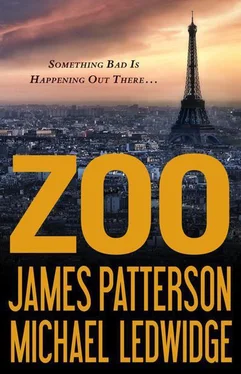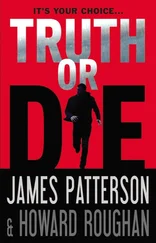Over the next hour, Chloe and I greeted the other scientists whom the government had shuttled in via Hummer and helicopter. In addition to my colleague Dr. Quinn, they had recruited most of the rest of the lab staff from Columbia as well as more than a dozen top-drawer entomologists, environmentalists, and other scientists.
“Ah, look who it is,” I said to Chloe behind my hand. “Dr. Harvey Blowhard.”
Chloe rolled her eyes.
Dr. Harvey Saltonstall, the Henry Wentworth Wallace chair in biology at Harvard, shook my hand and gave me a cold, curt hello. Being proved right before your enemies is a pretty good feeling, and I couldn’t help but smirk a little. I did not like this man. Last time I’d seen him he was on the other side of a split screen on MSNBC, with Rachel Maddow moderating. That was more than a year ago. As usual, he’d made me look like a wing-nut bozo with his whole aristocratic persona—this handsome devil in tweed, occasionally swiping back his elegant shock of silver hair.
Harvey Saltonstall’s prominent public opposition to HAC had delayed progress for years. Now, why wasn’t I surprised that the officious, elitist asswipe was front and center in the government team assembled to solve the problem?
Soon I was standing at the head of a conference table ringed with the country’s best and brightest. I hoped all the expertise gathered in this room would be enough. And that we weren’t too late.
I started out by quickly going over what I had seen that morning under Bryant Park.
“At first, I thought HAC had a viral origin,” I said, looking around the table from face to face. Everyone nodded back at me. “But after seeing the animals up close today, acting in such a bizarre way, I think it’s time to take a new approach. I think this has to do with pheromones. The dogs I saw today were displaying textbook pheromonal aggregation behavior. It’s my belief that some new kind of morphed pheromone has entered the environment, and it’s probably our doing, because we seem to be one of the only mammals whose behavior isn’t affected by it.”
“We came here for this?” Harvey Saltonstall took a long, fastidious sip from the cup of coffee in front of him while everyone waited for his next words. “The environment? Please. This theory is infantile. A pheromone is a chemical that’s very specific to communication within species. I’ve never heard of the same pheromone affecting multiple species. Are you suggesting there’s some invisible crazy gas affecting all mammals except humans? Why should it not affect us?”
Irritating as he was, I knew Saltonstall had an excellent point. He’d immediately stuck his finger in the biggest hole in my theory. I bit my lip and thought.
HARVEY SALTONSTALL MADE a prim cage of his fingertips and began to accordion them in and out, readying himself to redouble his attack. And then Chloe jumped in to save me.
“What about pollution?” she blurted.
“Yes, well, what about it?” Saltonstall said.
“Pollution in the environment sometimes causes mutational changes in animals. Take nylonase, for example. In a wastewater pond beside a nylon factory in Japan, they found a species of bacteria that only eats nylon. The presence of the pollution genetically altered the bacteria that were already there.”
“This stuff is all well and good when we’re talking about pollution,” said Saltonstall. “But I thought we were talking about pheromones. What does pollution have to do with pheromones?”
I rapped my knuckles on the table.
“Hydrocarbons,” I said. “That’s where pheromones and pollution connect. Pheromones are made up of hydrocarbons. So is petroleum.”
Around the table, everyone sat up a little straighter. My mind was racing. I couldn’t help it—I sprang to my feet and started pacing behind my chair.
“Hydrocarbons are everywhere,” I continued. “Over the last two hundred years, from car traffic and industrial activity, there’s been a massive increase in volatile hydrocarbons in the atmosphere. Methane, ethylene…”
“Not to mention the prevalence of petroleum,” Chloe said. “Petroleum is in everything—plastic, house paint, balloons, pillows, shampoo. It leaches into the groundwater.”
“Didn’t studies in the nineties explore the health hazards of plastics due to their chemical similarity to estrogens?” Dr. Terry Atkinson added. He was a chemical engineer from Cooper Union.
I felt like diving across the table and giving him a high five. I didn’t.
“Yes!” I said. “If hydrocarbons can mimic estrogen, it’s entirely conceivable that they can mimic pheromones.”
“Or take the plastic compound used in water bottles,” said Dr. Quinn, jabbing a pen in the air. “They found that it caused the estrogen levels of fish to skyrocket for some reason. In a lake outside a manufacturing plant in Germany, researchers found that there were no male fish present at all.”
“We are flying down the wrong path here, folks,” Saltonstall insisted. He cleared his throat and swiped back his silver shock of hair with his hand. “How do chemical hydrocarbons change without some sort of catalyst? Plastic has been around for over fifty years. If it affected the way animals process pheromones, wouldn’t we have noticed long before now?”
I let out a breath and tried to come up with an answer. Saltonstall again had raised a good counterargument.
“Excuse me, Mr. Oz,” said Betty Orlean, an environmental scientist from the University of Chicago. “Quick question. When did you start noticing this increase in animal aggression?”
“As far as my data show, around 1996,” I said. “But it didn’t start getting bad until the aughts.”
“Nineteen ninety-six is right around when cell phones started becoming more popular,” Betty said a bit cryptically. “And cell phone use has exponentially increased since then.” The thought was half formed in her head.
“So?” Saltonstall said.
“Well, Dr. Saltonstall,” she said, “we know that cell phones use radiofrequency energy, which forms fields of electromagnetic radiation. Some animal functions at the cellular level can be affected by such fields. The fear for years has been that one field could disrupt the other. That’s why there have been so many studies about the link between cell phone use and brain cancer. For years, our world has been swimming in an unprecedented sea of radiation.”
“Yes,” I said, really going now. “Perhaps cell phone radiation is somehow cooking the ambient environmental hydrocarbons in a way we’ve never seen before—morphing them into a chemical that animals are picking up as a pheromone. And it’s changing their cerebral physiology, as we’ve seen at Columbia. We know that the affected animals have bigger amygdalae.”
“Oz, I believe I remember something.” Dr. Quinn jumped in. “It was a study about bees in the Netherlands.” She spoke slowly and distractedly as she poked at the laptop open in front of her. “Yes, here it is. I’ll put it on the SMART board.”
A moment later, a graph-peppered scientific paper appeared on the screen.
“This was a study done in the Netherlands in the nineties,” she said. “It shows the effects of radiation on bees whose nest was relocated beside a cell phone tower. As you can see in table one, when the bees were in the forest, they had no trouble foraging and returning to the nest.”
She got up, walked forward, and pointed at the curving lines of a graph on the screen.
“But here in the second graph, it shows that when the nest was placed next to the cell phone tower, the bees took longer and longer to get back, until the hive eventually died off.”
“I, for one, am intrigued by Mr. Oz’s theory,” Dr. Orlean said. “I think we may have our culprits—pollution from hydrocarbons and electromagnetic radiation from cell phones have coupled together, resulting in critical biosphere meltdown.”
Читать дальше












